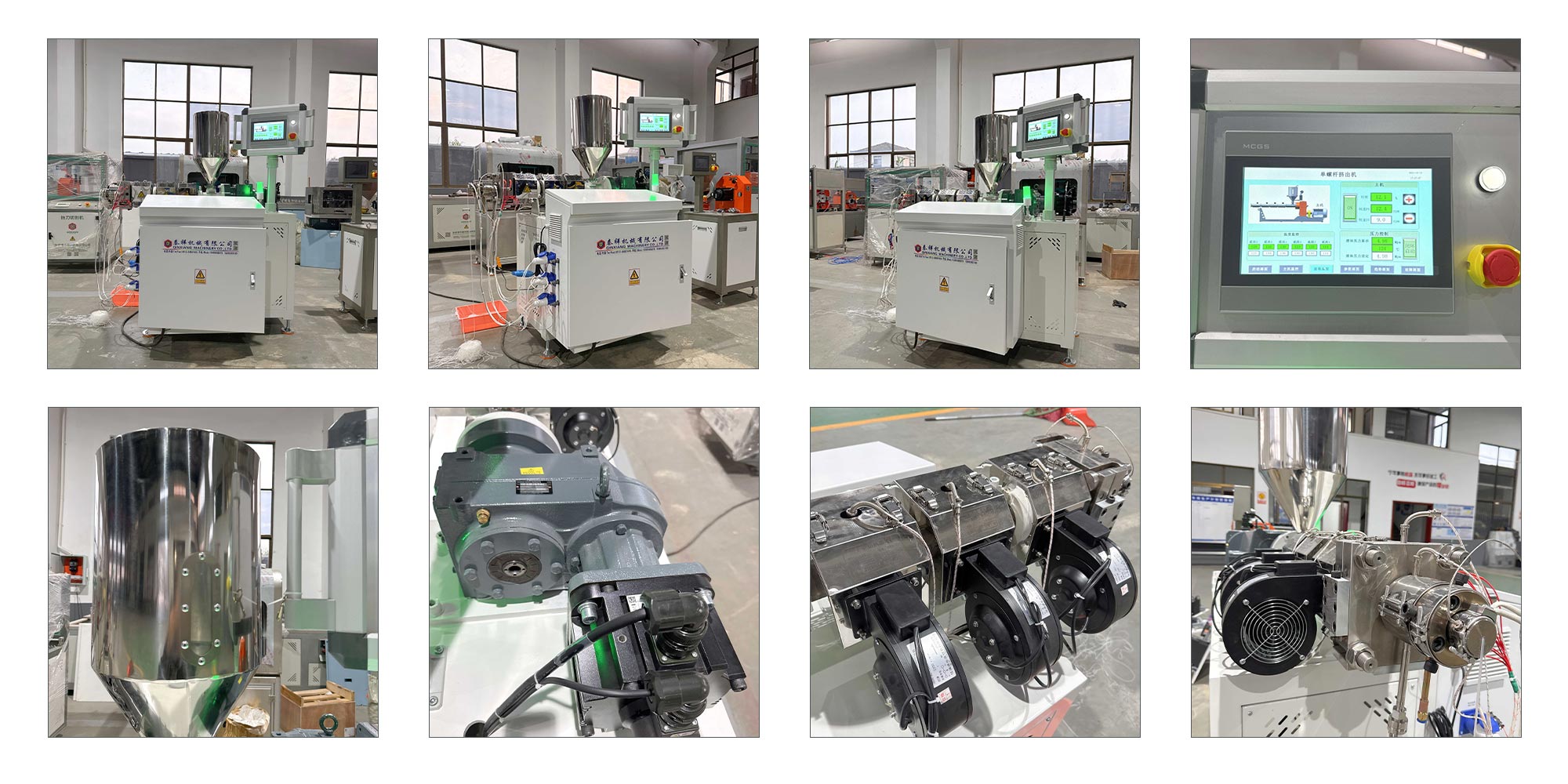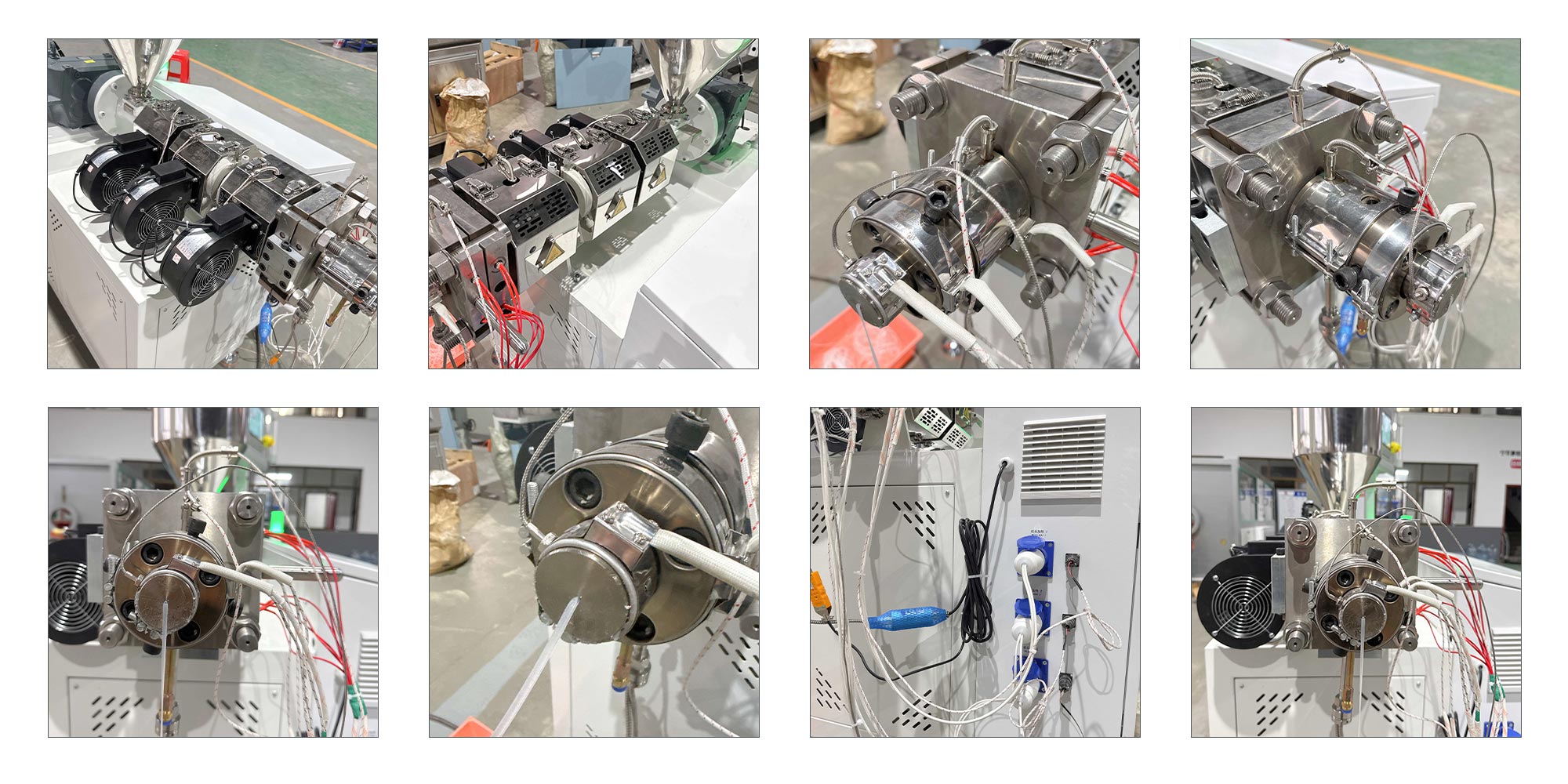Laboratory Extruder
VIDEO
Key Features of the Laboratory Extruder
Precise Process Control and Repeatability
Servo-driven feeders and closed-loop temperature control ensure stable melt profiles and repeatable results across runs.
High-resolution torque and pressure sensors provide real-time feedback for rheology and process window mapping.
Modular screw and barrel design supports quick reconfiguration of conveying, mixing, kneading, and devolatilization zones.
Broad Material Compatibility and Clean Handling
Handles commodity and engineering resins (PP, PE, PVC, ABS, PC, PA, PBT, TPU), elastomers, bio-based polymers, additives, fillers, and pigments.
Corrosion- and wear-resistant metallurgy options (bimetallic barrels, hardened screws) for abrasive or chemically aggressive compounds.
Enclosed feeding and venting with dust extraction interfaces for clean, safe bench-scale operation.
Smart Controls, Data Logging, and Recipe Management
PLC + touchscreen HMI with recipe library, step-wise temperature profiles, screw speed ramps, and alarm history.
Full data acquisition: melt temperature, melt pressure, torque, specific energy, feeder mass flow, and residence time index.
Ethernet connectivity (OPC UA/Modbus TCP) for LIMS/MES integration, CSV/PDF batch reports, and remote monitoring.
Fast Changeovers and Low Operating Cost
Tool-free die and screw segment change, quick-release feed hoppers, and self-cleaning purge routines minimize downtime.
Small material inventory per run reduces waste during screening and color/changeover trials.
Energy-efficient heaters and smart standby lower power consumption during idle periods.
Applications and Industries
Polymer R&D and Compounding
Masterbatch development, color matching, additive screening (UV stabilizers, antioxidants, antistats, FRs).
Filler optimization for CaCO3, talc, glass fiber, carbon black, and nanofillers with controlled dispersion.
Building and Construction
Pilot formulations for PVC profiles, cable ducts, sealing strips, and waterproofing membranes with controlled mechanical properties.
Furniture and Interior
Compounds for edge banding, decorative films, and laminates with stable gloss, shade, and scratch resistance.
Automotive and Electronics
Engineering plastics for interior trims, connectors, housings; FR performance tuning and VOC/odor optimization.
Healthcare and Sustainable Materials
Medical-grade TPU/PEBA trials (non-patient use lab evaluations), bio-based and recycled polymers, reactive extrusion pre-screening.
Technical Specifications
Performance and Capacity
Screw diameter: 16–35 mm (lab and pilot scale); L/D configurable from 24–48.
Throughput: approx. 0.2–25 kg/h depending on polymer, L/D, screw design, and venting.
Process modes: single-screw and twin-screw options; co-rotating twin-screw for intensive mixing; batch or continuous feeding.
Temperature, Torque, and Pressure
Barrel temperature zones: 4–10 zones, max setpoint 450°C (model dependent) with ±0.5°C stability.
Torque capacity: up to 120 N·m (size dependent); melt pressure sensors up to 300 bar with auto-zero.
Feeding, Venting, and Devolatilization
Gravimetric micro-feeders for powders, pellets, and liquids (0.05–30 kg/h).
Atmospheric and vacuum venting ports; optional side feeder for fillers/fibers; gear pump for melt stabilization.
Construction and Configuration
Wear packages: bimetallic barrels, HIP kneading blocks, nitrided or hardened shafts and screws.
Dies: strand, sheet, film, ribbon, and capillary rheology die; integrated water bath, air knife, and pelletizer options.
Safety: interlocked guards, e-stop, over-torque and over-pressure protection; ATEX options for dusty labs.
Controls, Connectivity, and Reporting
PLC/HMI with recipe versioning, user permissions, audit trail, and KPI dashboards (OEE, SEn, yield).
Interfaces: Ethernet, OPC UA, Modbus TCP; batch report export (CSV/PDF) and label printing.
Energy and Utilities
Power: 3–12 kW depending on size, heaters, and auxiliaries.
Compressed air: 0.4–0.6 MPa for strand cutting, valve actuation, and purge.
Smart standby and zone-by-zone heat scheduling reduce idle energy up to 20–30%.
Note: Specifications vary by screw diameter, L/D, and selected options. Custom lab-to-pilot configurations are available for seamless scale-up.
Customer Case
User Recognition and Market Performance
Customer Feedback
R&D teams report 30–60% faster formulation cycles due to rapid screw reconfiguration and accurate micro-feeding.
Operators commend intuitive HMI, stable temperature control, and low material consumption per trial.
Quality and lab managers value complete data logging for reproducibility and faster tech transfer to production lines.
Representative Case Studies
Masterbatch lab: reduced off-spec color trials by 25% and cut start-up scrap on production twin-screw by 15% through data-driven scale-up.
Automotive supplier: achieved consistent UL94 FR results across shifts using co-rotating twin-screw with precise venting control.
Building materials pilot line: improved impact/tensile balance in PVC formulations and shortened approval lead time by 30%.
Market Competitiveness
Differentiated by modular screw/barrel system, data-rich controls, and MES-ready connectivity for Industry 4.0 labs.
Strong ROI through reduced trial material, faster approvals, and predictable scale-up to production extruders.



